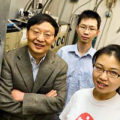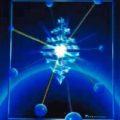
The weird laws of quantum mechanics govern how molecules, atoms and smaller particles behave, but quantum phenomena sometimes “leak up” to macroscopic scales, researchers at the University of Illinois have found. They have demonstrated that, counter to classical Newtonian mechanics, an entire collection of superconducting electrons in an ultrathin superconducting wire is able to “tunnel” as a pack from a state with a higher electrical current to one with a notably lower current, providing more evidence of the phenomenon of macroscopic quantum tunneling.
Alexey Bezryadin and Paul Goldbart led the team, with graduate student Mitrabhanu Sahu performing the bulk of the measurements, with the results appearing in Nature Physics.
Quantum tunneling is the capability of a particle to inhabit regions of space that would normally be off-limits according to classical mechanics. The team’s research observes a process called a quantum phase slip, whereby packs of roughly 100,000 electrons tunnel together from higher electrical current states to lower ones. The energy locked in the motion of the electrons as they phase slip is dissipated as heat, causing the nanowires to switch from a superconducting state to a more highly resistive one. This switching of states allows the tunneling of the phase slip to be observed.
The ultrathin superconducting nanowires fabricated and measured by Sahu are about 2,000 times finer than a single strand of human hair, which is still; “a substantially larger scale than where one typically expects to observe quantum tunneling,” Bezryadin said.
According to Bezryadin, it has long been established that single electrons can tunnel, but scant evidence has existed until now for the group tunneling of a large ensemble of superconducting electrons confined in a thin wire. “Observing switching events in superconducting nanowires at high-bias currents provides strong evidence for quantum phase slips,” he said. “Our experiments provide further evidence that the laws of quantum mechanics continue to govern large systems, composed of many thousands of electrons, acting as a single entity.”
The researchers believe that the knowledge gleaned from research into quantum tunneling could have applications in the field of quantum computing. “If we learn how to evade the factors that currently suppress quantum superpositions at the macro-scale,” Bezryadin said, “we would be better positioned to construct quantum bits for quantum computers, which could perform tasks with an enormous increase in speed and security.”
Related:
Quantum “Uncollapse” Muddies Definition Of Reality
Lab-Created Giant Atom Goes Classical
Real-World Quantum Effects Demonstrated








Comments are closed.